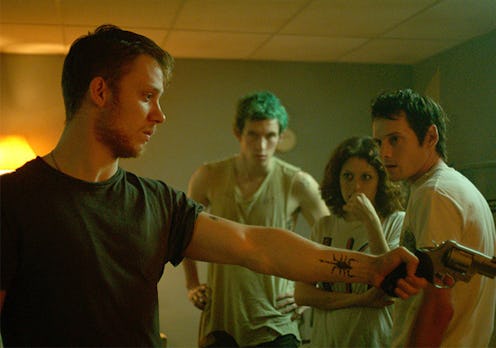Entertainment
'Green Room' Is Truly Terrifying

It's official: the Pacific Northwest has taken over our cultural imagination. From the glorious return of Sleater-Kinney to Netflix marathons of Portlandia to Voodoo Donut invading, well, everywhere, the ol' PNW is the place media wants to be at the moment. Riddled with Riot Grrrl and hardcore punk history, cities like Eugene and Seattle are once again total hotspots for movies, TV, and art, and now, with the release of the film Green Room, the region has become the focus of a horror-thriller. The movie focused on the struggle between neo-Nazis and a punk band, and while Green Room is not a true story, it does deal with the region's complicated history.
The movie follows a touring band who plays a show at a seedy, white supremacist bar, and who, afterwards, witness the neo-Nazi owners commit a murder. They are then locked up in the titular room, where they await their fates. "The film brutally toys with your sympathies as the band descends into hell, finds unlikely allies, and then tries to climb its way back out again," wrote Vox 's critic Todd VanDer Werff. "Not everybody will survive." And while it's much crunchier than the spooky and surreal Twin Peaks, for instance, Green Room is not based on reality. Instead, this violent flick bottles up the very real histories of neo-Nazi culture and hardcore punk, tosses in a few different made up stories, and gives it all a good shake.
For many people (including myself), the horrific idea of neo-Nazism was first introduced in American History X, the 1998 Ed Norton drama. Yet interestingly, the often-associated skinhead movement didn't begin with bigotry. Wrote the Southern Poverty Law Center in 2012, "The skinhead style first emerged as part of a non-racist and multiracial scene. White skinheads took on a persona that reflected admiration for and kinship with a new generation of working-class West Indian immigrants in the United Kingdom... Like the Jamaican immigrants of the time, the first skinheads were clean-cut, neat, and sharp-looking compared to the shaggier youth styles of the period."
The Law Center noted that it took almost 20 years for the skinhead movement to take on racist ideology, writing, "White power skinheads develop a separate subculture based on the white nationalist music of 'Rock Against Communism; bands like Skrewdriver, Skullhead, and No Remorse who opposed the 'Rock Against Racism' concerts of anti-racist skins." To perhaps oversimplify an incredibly complicated history, a ton of these anti-racist skinheads had a hand in developing the Pacific Northwest's hardcore punk scene. Local tensions brewed between the two sects, and ultimately resulted in many people leaving behind the skinhead identity. Green Room's writer and director, Jeremy Saulnier, said that his experiences with white supremacy in the hardcore scene had a heavy influence on the film. In an interview with Birth. Movies. Death . , Saulnier said:
In DC in the 90's, yes, there were some Nazi skinheads at some of these shows. And certainly, cinematically-speaking, Nazi bad guys are sort of a low-hanging fruit. But in the punk scene, that's who it is, y'know? They have an ideology that's about hate and separatism and aggression. They are the fucking bad guys! So, this wasn't like typecasting or whatever; this happens. And in the (punk) scene, these guys will often attract violence. So this was a very natural extension of my observations.
Sauliner said in the interview that he was particularly fascinated with the militant nature of the skinhead culture and used it to inform the crime at the center of Green Room. "Nazi skinheads were at the shows I went to back in Washington D.C. It was a little scary," he said in a conversation with The A.V. Club. "I was young. I was part of the hardcore punk scene, going to shows every other weekend. I was in a hardcore band. All my friends were in the punk scene. We weren’t just that."
While Saulnier survived his brushes with white supremacist skinheads, it sounds like his Green Room characters don't fare as well.
Images: Giphy; A24 Productions (2)